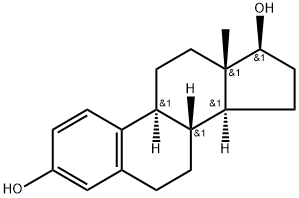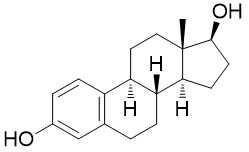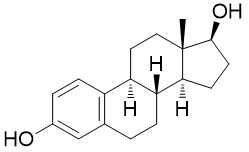-
High Light
50-28-2 Pharmaceutical Intermediates
,Β Estradiol Pharmaceutical Intermediates
,C18H24O2 Pharmaceutical Intermediates
-
Product Nameβ-ESTRADIOL
-
SynonymsBETA-ESTRADIOL-16,16,17-D3;17BETA-ESTRADIOL-16,16,17-D3;β-Estradiol, 99% (dry Wt.), Ca 3% Water;1,3,5-Estratriene-3,17beta-diol;17beta-Estradiol;3,17beta-Dihydroxy-1,3,5(10)-estratriene;Dihydrofolliculin;Estradiol
-
CAS50-28-2
-
MFC18H24O2
-
MW272.39
-
EINECS200-023-8
-
Melting Point178-179 °C(lit.)
-
Boiling Point355.44°C (rough Estimate)
-
Density1.0708 (rough Estimate)
-
Purity99%
-
Place of OriginChina
-
Brand NameRUN
-
CertificationIOS9001
-
Model NumberRUN-Z
-
Minimum Order Quantity10g
-
Priceinquiry
-
Packaging Details10g 50g 100g 500g 1kg
-
Delivery Time3-7 days
-
Payment TermsT/T, MoneyGram, BTCcoin
-
Supply Ability1kg --100kg
50-28-2 β Estradiol Hormone Drugs C18H24O2 200-023-8
SECTION 1: Basic information
| β-ESTRADIOL Basic information |
| Uses Indications and Usage Adverse reactions Contradictions |
| Product Name: | β-ESTRADIOL |
| Synonyms: | BETA-ESTRADIOL-16,16,17-D3;17BETA-ESTRADIOL-16,16,17-D3;β-Estradiol, 99% (dry wt.), ca 3% water;1,3,5-Estratriene-3,17beta-diol;17beta-Estradiol;3,17beta-Dihydroxy-1,3,5(10)-estratriene;Dihydrofolliculin;Estradiol |
| CAS: | 50-28-2 |
| MF: | C18H24O2 |
| MW: | 272.39 |
| EINECS: | 200-023-8 |
| Product Categories: | powder or crystal;Inhibitors;Intermediates & Fine Chemicals;API;VIVELLE;Hormone Drugs;Analytical Chemistry;Biochemistry;Environmental Endocrine Disruptors;Estradiol, etc. (Environmental Endocrine Disruptors);Hydroxysteroids;Intracellular receptor;Pharmaceuticals;Steroid and Hormone;Steroids;Estrogen;Hormone |
| Mol File: | 50-28-2.mol |
 |
|
| β-ESTRADIOL Chemical Properties |
| Melting point | 178-179 °C(lit.) |
| alpha | D25 +76 to +83° (dioxane) |
| Boiling point | 355.44°C (rough estimate) |
| density | 1.0708 (rough estimate) |
| refractive index | 80.4 ° (C=1, Dioxane) |
| Fp | 2℃ |
| storage temp. | 2-8°C |
| solubility | Practically insoluble in water, soluble in acetone, sparingly soluble in ethanol (96 per cent), slightly soluble in methylene chloride. |
| form | powder |
| pka | pKa 10.71±0.02(H2O(0.1% p-dioxane) t=25±0.1 I=0.03(KCl))(Approximate) |
| color | White to off-white |
| Water Solubility | Soluble in dimethyl sulfoxide, ethanol , water, phosphate buffer saline, dimethyl formamide, acetone, dioxane and alkali hydroxides. Slightly soluble in vegetable oils. |
| Merck | 14,3703 |
| BRN | 1914275 |
| Stability: | Stable. Incompatible with strong oxidizing agents. |
| InChIKey | VOXZDWNPVJITMN-ZBRFXRBCSA-N |
| CAS DataBase Reference | 50-28-2(CAS DataBase Reference) |
| NIST Chemistry Reference | Estra-1,3,5(10)-triene-3,17beta-diol(50-28-2) |
| EPA Substance Registry System | Estradiol (50-28-2) |
| Safety Information |
| Hazard Codes | T,Xn,F |
| Risk Statements | 60-61-45-63-64-40-36-20/21/22-11-48 |
| Safety Statements | 53-22-36/37/39-45-36/37-26-16-36-20 |
| RIDADR | 2811 |
| WGK Germany | 3 |
| RTECS | KG2975000 |
| F | 8-10 |
| HazardClass | 6.1 |
| PackingGroup | III |
SECTION 2: Hazard identification
2.1 Classification of the substance or mixture
Carcinogenicity, Category 2
Reproductive toxicity, Category 1A
Reproductive toxicity, Additional category for effects on or via lactation
Hazardous to the aquatic environment, short-term (Acute) - Category Acute 1
Hazardous to the aquatic environment, long-term (Chronic) - Category Chronic 1
2.2 GHS label elements, including precautionary statements
| Pictogram(s) | |
|---|---|
| Signal word | Danger |
| Hazard statement(s) |
H351 Suspected of causing cancer H360 May damage fertility or the unborn child H362 May cause harm to breast-fed children H410 Very toxic to aquatic life with long lasting effects |
| Precautionary statement(s) | |
| Prevention |
P203 Obtain, read and follow all safety instructions before use. P280 Wear protective gloves/protective clothing/eye protection/face protection/hearing protection/... P260 Do not breathe dust/fume/gas/mist/vapours/spray. P263 Avoid contact during pregnancy and while nursing. P264 Wash ... thoroughly after handling. P270 Do not eat, drink or smoke when using this product. P273 Avoid release to the environment. |
| Response |
P318 IF exposed or concerned, get medical advice. P391 Collect spillage. |
| Storage | P405 Store locked up. |
| Disposal | P501 Dispose of contents/container to an appropriate treatment and disposal facility in accordance with applicable laws and regulations, and product characteristics at time of disposal. |
2.3 Other hazards which do not result in classification
no data available
SECTION 3: Composition/information on ingredients
3.1 Substances
| Chemical name | Common names and synonyms | CAS number | EC number | Concentration |
|---|---|---|---|---|
| Estradiol | Estradiol | 50-28-2 | 200-023-8 | 100% |
SECTION 4: First-aid measures
4.1 Description of necessary first-aid measures
If inhaled
Move the victim into fresh air. If breathing is difficult, give oxygen. If not breathing, give artificial respiration and consult a doctor immediately. Do not use mouth to mouth resuscitation if the victim ingested or inhaled the chemical.
Following skin contact
Take off contaminated clothing immediately. Wash off with soap and plenty of water. Consult a doctor.
Following eye contact
Rinse with pure water for at least 15 minutes. Consult a doctor.
Following ingestion
Rinse mouth with water. Do not induce vomiting. Never give anything by mouth to an unconscious person. Call a doctor or Poison Control Center immediately.
4.2 Most important symptoms/effects, acute and delayed
no data available
4.3 Indication of immediate medical attention and special treatment needed, if necessary
Immediate first aid: Ensure that adequate decontamination has been carried out. If patient is not breathing, start artificial respiration, preferably with a demand valve resuscitator, bag-valve-mask device, or pocket mask, as trained. Perform CPR if necessary. Immediately flush contaminated eyes with gently flowing water. Do not induce vomiting. If vomiting occurs, lean patient forward or place on the left side (head-down position, if possible) to maintain an open airway and prevent aspiration. Keep patient quiet and maintain normal body temperature. Obtain medical attention. Poisons A and B
SECTION 5: Fire-fighting measures
5.1 Suitable extinguishing media
Use dry chemical, carbon dioxide or alcohol-resistant foam.
5.2 Specific hazards arising from the chemical
no data available
5.3 Special protective actions for fire-fighters
Wear self-contained breathing apparatus for firefighting if necessary.
SECTION 6: Accidental release measures
6.1 Personal precautions, protective equipment and emergency procedures
Avoid dust formation. Avoid breathing mist, gas or vapours.Avoid contacting with skin and eye. Use personal protective equipment.Wear chemical impermeable gloves. Ensure adequate ventilation.Remove all sources of ignition. Evacuate personnel to safe areas.Keep people away from and upwind of spill/leak.
6.2 Environmental precautions
Prevent further spillage or leakage if it is safe to do so. Do not let the chemical enter drains. Discharge into the environment must be avoided.
6.3 Methods and materials for containment and cleaning up
Collect and arrange disposal. Keep the chemical in suitable and closed containers for disposal. Remove all sources of ignition. Use spark-proof tools and explosion-proof equipment. Adhered or collected material should be promptly disposed of, in accordance with appropriate laws and regulations.
SECTION 7: Handling and storage
7.1 Precautions for safe handling
Handling in a well ventilated place. Wear suitable protective clothing. Avoid contact with skin and eyes. Avoid formation of dust and aerosols. Use non-sparking tools. Prevent fire caused by electrostatic discharge steam.
7.2 Conditions for safe storage, including any incompatibilities
Do not store unpouched. Apply immediately upon removal from the protective pouch.
SECTION 8: Exposure controls/personal protection
8.1 Control parameters
Occupational Exposure limit values
no data available
Biological limit values
no data available
8.2 Appropriate engineering controls
Ensure adequate ventilation. Handle in accordance with good industrial hygiene and safety practice. Set up emergency exits and the risk-elimination area.
8.3 Individual protection measures, such as personal protective equipment (PPE)
Eye/face protection
Wear tightly fitting safety goggles with side-shields conforming to EN 166(EU) or NIOSH (US).
Skin protection
Wear fire/flame resistant and impervious clothing. Handle with gloves. Gloves must be inspected prior to use. Wash and dry hands. The selected protective gloves have to satisfy the specifications of EU Directive 89/686/EEC and the standard EN 374 derived from it.
Respiratory protection
If the exposure limits are exceeded, irritation or other symptoms are experienced, use a full-face respirator.
Thermal hazards
no data available

